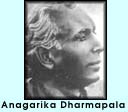 |
 19th September 1999 |
Front Page| |
A birth anniversary pen sketchDharmapala - the ColossusBy Upali Salgado
This remarkable man, Don David Hewavitharane, from an educated and respected family of Matara, later changed his name to Dharmapala. He took to the bramachari (celibate) life and became better known as Anagarika Dharmapala. Dharmapala was often seen at railway stations, esplanades, and at Poya Day gatherings fearlessly addressing Sinhala Buddhists, reminding them that they were all equal if not superior to the British colonial raj. He laughed at his own friends who aped the English way of life, wearing long trousers and top hats. He appealed to them to shed their false western values, and think of their own culture, and asked women not to wear the Dutch-style long flared gown, but to wear the lama saree. He even advocated that milk rice (kiribath) be served on important occasions such as weddings, and not the rich cake which contained brandy. This nationalist, travelled in an old bus carrying with him a hailer to address gatherings. His vehicle was colourfully painted with slogans written in Sinhala such as: "Those who consume liquor are barbarians", "Do respect animal life- beef eaters should be shunned by all". Dharmapala often reminded his followers that good clothes and big machines did not make a civilized man. He called the Englishmen, "uncivilized barbarians who exploited the hapless people of our country." Dharmapala was born one hundred and thirty five years ago on September 17, 1864, and died sixty nine years later on April 29, 1933, at Saranath, near Benares, where Sakyamuni Gothama Buddha preached his first sermon. His vision was twofold: to create in his peoples' minds the conviction that they had a rich culture which should be preserved and to seize control of the majestic Buddha Gaya Temple, built by Emperor Asoka. Dharmapala relentlessly fought the Mahant under whose control Buddha Gaya Temple was then, in several Courts of Law in Bihar and in Calcutta, and paved the way, through the efforts of the Maha Bodhi Society, which he founded. A later government of the Republic of India, headed by President Rajendra Prasad. and Nehru handed back this holy site to be controlled by a committee of Buddhists and Hindus. On several occasions, Dharmapala was jailed for no valid reason just because the colonial masters believed that he was an anti-British rabble- rouser. When the 1914-15 Sinhala Muslim riots broke out in Kandy and Gampola, though he was not in Ceylon at that time, he was arrested merely because he published a tabloid in Sinhala, titled "The Sinhala Baudhaya". He was kept for over a year in a jail, in Calcutta. Together with his lieutenant Walisinghe Harischandra from Hunupitiya, a hamlet off Negombo, he on Poya days addressed large gatherings at Anuradhapura and at Mihintale. They were both equally clever, fiery orators, who could rouse the sentiments of people. Both were interested in promoting local industries, and they established a school at Foster Lane in Maradana, a weaving centre, a printing press and an industrial school at Rajagiriya. These were managed by Walisinghe. Anagarika Dharmapala was born at a time when the Buddhist revivalist movement was to take place. He lived to see the efforts of Henry S. Olcott, Ven. Migettuwatte Gunananda Thera, Ven. Weligama Sri Sumangala Mahanayake Thera, the Ven. Hikkaduwe Sri Sumangala Nayake Thera, Pali scholar F.I.Woodward, Principal of Mahinda College, Galle, Carolis Pujitha Gunawardena, J. Teadbeater of Ananda College and Sir Baron Jayatileke, who founded the YMBA. He blazed the trail for others to follow, namely Dr.W.A.de Silva, Piyadasa Sirisena, Ven. S.Mahinda, P.de S. Kularatne, and Prof. Gunapala Malalasekera. Dharmapala was no politician. His passion was his religion. His aspiration was to take control of the Buddha Gaya Temple, which he saw neglected when at the age of 29, he first visited it. Later, he developed Saranath and built the majestic looking Mulagandhi - Kuta Vihare, in which place are enshrined the Buddha relics found at Taxila. At Saranath, he also founded a school, where Buddhist missionaries headed by the Ven. Heenetiyane Dhammaloka Thera later resided and preached the Buddha Dharma. The Maha Bodhi Society he founded, was a powerhouse for Buddhist activity that spearheaded his ideas. Today, at the turn of the twentieth century, Buddhists speak of Anagarika Dharmapala as a great missionary. As a leader there has been none to equal, the work he did, sometimes single handed. Before his demise, he donned the saffron robe, received higher ordination, and took the name of Devamitta. It was his last wish that he be reborn on earth as a human, to serve his country for many more years as a Buddhist. He passed away at Saranath, and was cremated with great honour, with the trappings of a sandalwood pyre, as is sometimes done, in India. |
||
 |
Front Page| News/Comment| Editorial/Opinion| Business| Sports | Mirror Magazine |
|
 |
Please send your comments and suggestions on this web site to |
|
 When
we look back at this century there is one man who stood out with a vision
and infinite courage to drive home in the minds of his countrymen, their
inherent right to live with self respect and preserve their culture.
When
we look back at this century there is one man who stood out with a vision
and infinite courage to drive home in the minds of his countrymen, their
inherent right to live with self respect and preserve their culture.